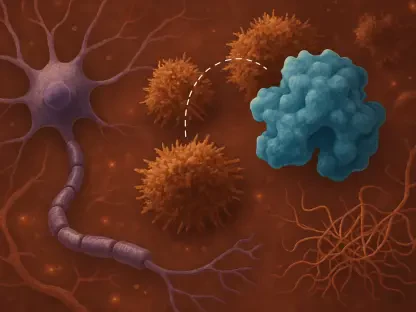In recent months, pivotal discoveries in melanoma research have unveiled game-changing insights that could reshape the therapeutic landscape for one of the most aggressive skin cancers. Traditionally, treatment options for melanoma have struggled with effectively targeting the disease due to its high metastatic potential and ability to develop resistance. However, a study published in CANCER, a peer-reviewed journal of the American Cancer Society, has spotlighted a critical vulnerability in the excessive mitochondrial dependence of aggressive melanomas. This research not only pinpoints mitochondrial overactivity as a significant survival factor for melanoma cells but also provides a promising new pathway to develop targeted therapies. By effectively exploiting this weakness through the use of existing drugs, researchers could pave the way for a revolutionized treatment approach, challenging the conventional methodologies that have so far defined melanoma therapy.
Uncovering a Therapeutic Vulnerability
The central focus of this groundbreaking research revolves around identifying hyperactivity in two key mitochondrial processes that are intricately involved in the survival and proliferation of aggressive melanoma cells. Mitochondria, often referred to as the powerhouses of the cell, are critical for energy production. However, in aggressive melanoma tumors, these cellular components are found to be excessively activated. Researchers meticulously mapped proteins expressed in samples from 151 melanoma tumors, comparing them to normal skin tissues. This approach allowed scientists to reveal significant differences in mitochondrial function. These differences underscore a newfound understanding that these tumors rely on enhanced mitochondrial activity for their survival, creating a potential target for treatment.
The novel insight that blocking these mitochondrial processes can impede melanoma cell survival presents a substantial shift in treatment strategy. This insight is further validated by the effectiveness of using existing drugs, such as antibiotics and energy-production inhibitors, to selectively target these pathways. Antibiotics, traditionally designed to disrupt bacterial protein synthesis, can be repurposed to interfere with the similar protein synthesis machinery in mitochondria, effectively compromising melanoma cells’ ability to thrive. This therapeutic avenue holds promise due to its specificity and limited impact on non-cancerous skin cells, hinting at reduced side effects and improved patient safety.
The Role of Existing Drugs in Treatment
A key advantage of this discovery lies in the potential to fast-track the implementation of these therapies by utilizing existing drugs with established safety profiles. The identification of an Achilles’ heel in melanoma tumors’ mitochondrial energy reliance opens doors for integrating mitochondrial blockers with current treatment standards. This strategy aims to cut off major escape routes that cancers exploit for therapy resistance and relapse. Emphasizing the clinical implications, Dr. Jeovanis Gil from Lund University, Sweden, underscores the relevance of the study’s findings. The research successfully identifies a mitochondrial-protein signature that could serve as a biomarker for categorizing patients most likely to benefit from mitochondrial-targeted therapies. Such advancements support the movement towards precision medicine in melanoma treatment, offering hope for more personalized and effective therapeutic outcomes.
Moreover, the potential applications extend beyond melanoma, suggesting that the mitochondrial rewiring detected in this study might apply to various other cancer types. Broadening the scope of these findings could, therefore, inform treatment approaches in a wide range of malignancies. By honing in on cancers’ mitochondrial dependencies, oncologists and researchers could devise personalized combination strategies that further the fight against cancer resistance and recurrence. The impact of these strategies, leveraging the existing pharmacological arsenal, heralds a future of cancer treatment pathways that are not only innovative but also pragmatic.
The Shift Toward Precision Medicine
This study’s emphasis on targeting specific biological mechanisms dominant in aggressive cancer types aligns with the broader shift in oncology toward precision medicine. Moving away from the one-size-fits-all approach allows researchers and clinicians to exploit the unique vulnerabilities of individual tumors, such as melanoma’s mitochondrial dependency, for more effective interventions. This transition highlights the importance of understanding cancer at a molecular and cellular level to design treatments that reflect the biological nuances of the disease. Such targeted approaches not only enhance therapeutic efficacy but also contribute to reducing unnecessary toxicity associated with traditional treatments.
Furthermore, the paradigm shift represented by these findings is marked by the innovative application of drug repositioning — the process of identifying new therapeutic uses for existing drugs. This strategy not only facilitates a quicker transition from research to clinical application but also builds upon the known safety profiles of these medications, expediting the introduction of effective melanoma treatments. The identification of patients best suited for these therapies, through biomarkers, promises to enhance outcomes by allowing treatments to be tailored to the intricacies of each tumor type.
Advancing Cancer Research
Beyond its immediate implications for melanoma, this research positions itself within the larger landscape of cancer treatment advancements, contributing to a deeper understanding of cancer biology. By revealing the central role of mitochondrial function in cancer proliferation and survival, the study aids in mapping the broader therapeutic landscape. Such insights foster the development of more nuanced and targeted strategies that can potentially be adapted for application across various cancer types.
Ultimately, the insights derived from this research could be instrumental in shaping future drug development strategies by encouraging the investigation of mitochondrial pathways as a recurring theme in cancer resistance mechanisms. This broader perspective aligns with ongoing efforts to innovate within the field of oncology, with the goal of providing more effective, patient-specific treatment options.
Forging Future Advances
The research focuses on identifying increased activity in two critical mitochondrial processes tied to the survival and growth of aggressive melanoma cells. Known as the powerhouses of cells, mitochondria are vital for energy creation. In aggressive melanoma tumors, these components are found to be over-activated. Researchers mapped proteins from 151 melanoma tumor samples and compared them to normal skin tissues. This method revealed major differences in mitochondrial function, highlighting that tumors depend on boosted mitochondrial activity to survive, suggesting a target for treatment. The realization that disrupting these mitochondrial processes can halt melanoma cell survival marks a significant shift in treatment approaches. This theory is supported by the successful use of current drugs, like antibiotics and energy-production inhibitors, to target these pathways. Antibiotics can be repurposed to disrupt mitochondrial protein synthesis, weakening melanoma cell viability. This directed therapy is promising due to its precision and reduced effects on non-cancerous cells, hinting at fewer side effects and better patient safety.









